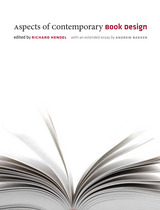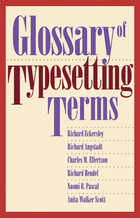2 books about Hendel, Richard

Aspects of Contemporary Book Design
Richard Hendel
University of Iowa Press, 2013
In this manifestly practical book, Richard Hendel has invited book and journal designers he admires to describe how they approach and practice the craft of book design. Designers with interesting and varied careers in the field, who work with contemporary technology in today’s publishing environment, describe their methods of managing the challenges presented by specific types of books, presented side by side with numerous images from those books. Not an instruction manual but a unique, on-the-job, title page–to–index guide to the ways that professional British and American designers think about design, Aspects of Contemporary Book Design continues the conversation that began with Hendel’s 1998 classic, On Book Design.
Contributing designers who focus on solving problems posed by nonfiction, fiction, cookbooks, plays, poetry, illustrated books, and journals include Cherie Westmoreland, Amy Ruth Buchanan, Mindy Basinger Hill, Nola Burger, Ron Costley, Kristina Kachele, Barbara Wiedemann, and Sue Hall, as well as a host of other designers, typesetters, editors, and even an author. Abbey Gaterud attempts to define the conundrum that the e-book presents to designers; Kent Lew describes the evolution of his Whitman typeface family; Charles Ellertson reflects upon the vital relationship between the typesetter and the designer; and Sean Magee writes about the uneasy alliance between designers and editors. In an extended essay that is as frank and funny as it is illuminating, Andrew Barker takes the reader deep into the morass—excavating the fine, finer, and finest details of working through a series design.
[more]

Glossary of Typesetting Terms
Richard Eckersley, Richard Angstadt, Charles M. Ellertson, and Richard Hendel
University of Chicago Press, 1994
Glossary of Typesetting Terms is an up-to-date reference book on the craft of typography. It organizes a dictionary and a style guide into a single, one-stop resource.
Prepared by a team of leading professionals—a designer, an editor, compositors, and production managers—this glossary will be valuable to anyone who works in publishing or printing for its definitions of typographical terms and concise treatment of typographical style.
The glossary adds important details to discussions of typography that are covered more generally in editorial style guides such as The Chicago Manual of Style. It is indispensable to anyone who prepares text for a living, including those who implement their own typesetting decisions with the aid of word-processing and page-layout software.
This manual furnishes a common technical vocabulary for specialists and nonspecialists alike. More than 900 entries provide up-to-date meanings for traditional terms like kerning,bleed, and thumbnail and definitions of new phrases like global search and replace,H & J (hyphenation and justification), and idiot file that have been developed to describe the role of computer technology in typesetting.
Eight appendixes offer additional guidance. The house style sheets of a major typesetter provide a sample checklist of items that affect the way in which words are composed into professional-quality type. Other appendixes cover families of type, the parts of a book, diagrams of the parts of a letter, coding and marking a manuscript in the precise language of typesetters, writing specifications for tables, proofreaders’ marks, and special characters.
No other reference book makes the vocabulary and practices of contemporary typesetting so accessible.
Prepared by a team of leading professionals—a designer, an editor, compositors, and production managers—this glossary will be valuable to anyone who works in publishing or printing for its definitions of typographical terms and concise treatment of typographical style.
The glossary adds important details to discussions of typography that are covered more generally in editorial style guides such as The Chicago Manual of Style. It is indispensable to anyone who prepares text for a living, including those who implement their own typesetting decisions with the aid of word-processing and page-layout software.
This manual furnishes a common technical vocabulary for specialists and nonspecialists alike. More than 900 entries provide up-to-date meanings for traditional terms like kerning,bleed, and thumbnail and definitions of new phrases like global search and replace,H & J (hyphenation and justification), and idiot file that have been developed to describe the role of computer technology in typesetting.
Eight appendixes offer additional guidance. The house style sheets of a major typesetter provide a sample checklist of items that affect the way in which words are composed into professional-quality type. Other appendixes cover families of type, the parts of a book, diagrams of the parts of a letter, coding and marking a manuscript in the precise language of typesetters, writing specifications for tables, proofreaders’ marks, and special characters.
No other reference book makes the vocabulary and practices of contemporary typesetting so accessible.
[more]
READERS
Browse our collection.
PUBLISHERS
See BiblioVault's publisher services.
STUDENT SERVICES
Files for college accessibility offices.
UChicago Accessibility Resources
home | accessibility | search | about | contact us
BiblioVault ® 2001 - 2024
The University of Chicago Press









